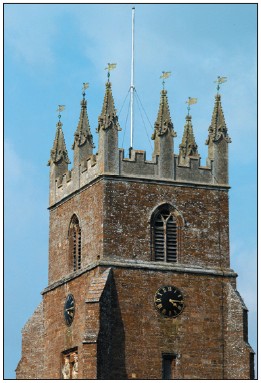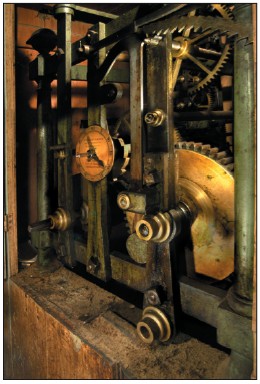Millennium Project
DEDDINGTON CHURCH CLOCK - history and mystery.
by Norman Stone


William Hudson, who gave his name to Hudson Street, was a prosperous citizen of 19th century Deddington. Before he died, in 1832, he expressed a wish that 'the old church clock should give way to a better'.
Draper, grocer and general storekeeper, Hudson had premises in the Market Place that were subsequently occupied by 'Ticky' Wells, so called because he sold goods on 'tick', or credit, when times were bad, which they usually were. Wells was followed by Chislett's, who in turn gave way to Deddington Sale Rooms, now part of Philip Allan Updates, and the distinctive projecting shop front demolished.
It was said that Hudson gave the church clock "out of farthings". One day he went to get out a teapot for a party he was giving, and sovereigns began dropping out of it on to the floor. "Never mind", said Bill, "a sovereign or two don't matter". Farthings or sovereigns, there was enough money for Hudson's heirs to honour his wish, and the new clock was installed in 1833 by Thomas Fardon, clockmaker of Deddington, whose name is inscribed on the indicator dial.

There were two Thomas Fardons, both assuredly clockmakers, and both undeniably of Deddington. But neither of them made Deddington church clock. The maker was William Taylor, a turret clock and chime maker and bell founder, of W & J Taylor, St Ebbe's Street, Oxford. Taylor's Deddington clock, which cost £176, was 'in a massive cast iron frame with cylindrical pillars and ball finials: two trains, rack striking and maintaining power. The rack is vertically disposed, toothed on both sides with the gathering pallet below; striking control by means of a peg and lever; the hammer pegs semi-circular in section; the fan 3-bladed. The escapement is a recoil anchor with a wooden rod pendulum about 18 feet overall'. Generations of Deddingtonians climbed the stairs of the bell tower to wind the clock until, in 1989, an electric winding system took over.
The Thomas Fardon who installed Taylor's clock, made watches and long case clocks. He was a well-known repairer and restorer, and was also an ironmonger. In January 1806 he was paid £7.7s.0d. for a clock for St Mary's Church, Kidlington, and 11s. for putting it up. However this was "probably not a turret clock as local tradition refers to a clock on the east wall of the nave, which was eventually removed as it distracted the attention of the congregation." Did Thomas Fardon ever make a turret clock? Perhaps the Deddington church job was too daunting for someone with no track record, or maybe he just couldn't match Taylor's price. For me, the most interesting part of the whole story is the clock that isn't there. Nothing is known about the clock that 'gave way to a better'. No clock of any kind is shown in Skelton's engraving of the church or Whittock's lithograph, both of which pre-date the 1833 clock. What was the earlier clock like? Was it a wall clock, inside the church? Who made it, and when? Does anybody have any authenticated evidence?
Editor's note: This article was written by Norman Stone and originally published in The Deddington News in May 2007. We are extremely grateful for his permission to reproduce it above. Norman has written other articles about the Fardon family. These can be found in the October, November and December issues 1994 of the Deddington News.
The photographs are by courtesy of Colin Robinson, artist photographer and Deddington resident.
Other useful links: